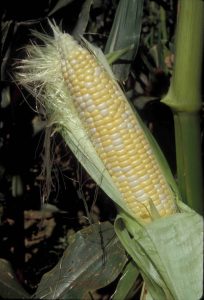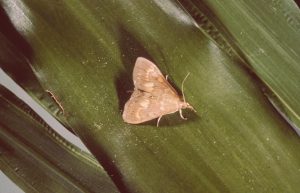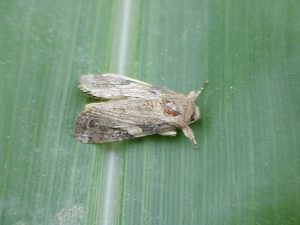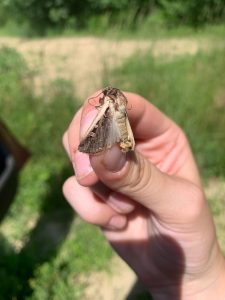Sweet Corn IPM Newsletter No. 8 – August 23, 2021

Sweet Corn IPM Newsletter No. 8 – August 23, 2021
Click on photos to enlarge.
PEST NUMBERS HIGHER IN MOST LOCATIONS
Protection Against Earworm, Armyworm and Borer Recommended
SITUATION
More warm weather and rain continue to push maturity of late planted corn varieties. As we move towards the Labor Day Weekend, quality is mostly reported as good. Corn earworm numbers were higher in some locations this week, and most sites are now on a spray schedule for silking corn. Fall army worm and European corn borer counts were also higher at some sites, but feeding damage on pre-tassel corn remains low. The tropical storm moving through the region may result in a significant increase in pest pressure in the coming days.

European corn borer:
No fields were over the 15% control threshold for feeding activity this week. European corn borer moth trap counts were over the silking spray threshold of 5/week at sites in Cape Elizabeth, Lewiston and Monmouth, but all of these sites are now on a spray schedule for corn earworm, which should provide control of corn borer as well.

Corn earworm:
Pheromone trap moth captures were variable around the state, with some sites having no moths and others seeing some of the higher counts for the season. A 4-day spray schedule was recommended for Biddeford, Cape Elizabeth, Lewiston, New Gloucester and one site in Wells. A 5-day spray schedule was recommended in Monmouth, Wayne and one site in Wells. Continue protecting silking corn until five to seven days before harvest, or once silks are thoroughly dry and brown.

Fall armyworm:
Moths counts were higher at some sites, but the distribution was scattered around the state. At this point in the season, moths are more likely to lay their eggs on the flag leaves of silking corn, allowing the larvae to move into the ears without leaving visible feeding signs on the foliage. Silking corn that isn’t under a spray schedule for earworm should be protected when the trap counts exceed the threshold of 3 moths per week. Eight sites were over threshold this week, including: Auburn, Biddeford, Farmington, Monmouth, New Gloucester, Oxford, Wayne, and one Wells site. Sprays were recommended at sites where a spray schedule for corn earworm was not recommended, including Auburn, Farmington and oxford. No significant feeding damage has been found in the fields, but we expect to see it soon.

Western Bean Cutworm:
Moths dropped from earlier highs, ranging from 0 to 7. We are recommending that silking corn be protected if more than 3 moths are caught, and sprays are not already being applied to control corn earworm and/or fall armyworm.

Powdery Mildew:
Weather conditions continue to be very favorable for the development of powdery mildew on pumpkins and squash. Be on the lookout for symptoms on plants and be ready to protect fields with a registered fungicide. Once symptoms are noticed, apply an effective fungicide and begin a weekly spray schedule. Many older fungicides are no longer effective on resistant strains of powdery mildew. Current research at Cornell University suggests newer products including Procure®, Proline®, Luna Experience® and Rhyme® are still effective on most strains of this fungus disease.
Sincerely,
David T. Handley
Vegetable & Small Fruit Specialist
Highmoor Farm Pest Management Unit
P.O. Box 179 17 Godfrey Drive
52 U.S. Route 202 Orono, ME 04473
Monmouth, ME 04259
207.933.2100 1.800.287.0279
| Location | CEW
Moths |
ECB
Moths |
FAW
Moths |
%Feeding
Damage |
Recommendations / Comments |
|---|---|---|---|---|---|
| Auburn | 0 | 0 | 6 | 1% | One spray for FAW on silking corn |
| Biddeford | 8 | 1 | 18 | 2% | 4-day spray interval for silking corn |
| Bowdoinham | 0 | 0 | 0 | 2% | No spray recommended |
| Cape Elizabeth | 38 | 5 | 2 | 5% | 4-day spray interval for silking corn |
| Dayton I | 0 | 0 | 0 | 1% | No spray recommended |
| Dayton II | 0 | 4 | 0 | 0% | No spray recommended |
| Farmington | 0 | 4 | 3 | 0% | One spray for FAW on silking corn |
| Lewiston | 8 | 27 | 0 | 0% | 4-day spray interval for silking corn |
| Monmouth | 4 | 10 | 23 | 0% | 5-day spray interval for silking corn |
| New Gloucester | 31 | 0 | 34 | 1% | 4-day spray interval for silking corn |
| Oxford | 0 | 0 | 5 | 14% | One spray for FAW on silking corn |
| Sabattus | 0 | 0 | 0 | 0% | No spray recommended |
| Wayne | 5 | 1 | 3 | 5% | 5-day spray interval for silking corn |
| Wells I | 7 | 0 | 0 | 0% | 5-day spray interval for silking corn |
| Wells II | 15 | 0 | 4 | 0% | 4-day spray interval for silking corn |
CEW: Corn earworm (Only fresh silking corn should be sprayed for this insect.)
ECB: European corn borer
FAW: Fall armyworm
| Moths caught per week | Moths caught per night | Spray interval |
|---|---|---|
| 0.0 to 1.4 | 0.0 to 0.2 | No spray |
| 1.5 to 3.5 | 0.3 to 0.5 | Spray every 6 days |
| 3.6 to 7.0 | 0.6 to 1.0 | Spray every 5 days |
| 7.1 to 91 | 1.1 to 13.0 | Spray every 4 days |
| More than 91 | More than 13 | Spray every 3 days |
Thresholds apply only to corn with exposed fresh silk. Lengthen spray intervals by one day if maximum daily temperature is less than 80°F.
European Corn Borer Thresholds
Whorl stage: 30% or more of plants scouted show injury.
Pre-tassel-silk: 15% or more of plants scouted show injury.
Silk: 5 or more moths caught in pheromone traps in one week.
IPM Web Pages:
Where brand names or company names are used, it is for the reader’s information. No endorsement is implied nor is any discrimination intended against other products with similar ingredients. Always consult product labels for rates, application instructions and safety precautions. Users of these products assume all associated risks.
The University of Maine is an equal opportunity/affirmative action institution.
